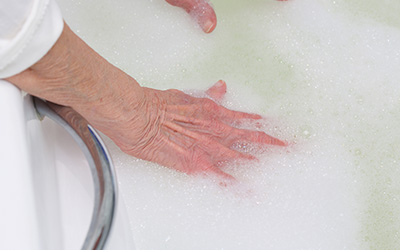Bathing
Bathing can be a challenge because people living with Alzheimer’s may be uncomfortable receiving assistance with such an intimate activity. They may also have depth perception problems that make it scary to step into water. They may not perceive a need to bathe or may find it a cold, uncomfortable experience. If people regard bathing as scary, embarrassing, unpleasant or uncomfortable, they may communicate their discomfort by verbally and/or physically resisting attempts to bathe. In some cases, this can escalate and become be unsafe and upsetting for all who are involved.
There are ways to make bathing easier and more comfortable — however, each situation is unique, and finding what works is often the result of trial and error. For more bathing ideas, join ALZConnected, our online support community where caregivers like you share tips on bathing a person living with dementia.
Prepare the bathroom in advance
 Encourage the person to do as much as possible, but be ready to assist when needed. In the earlier stages, the person may only need a reminder to bathe. As dementia progresses, he or she will require more assistance. Prepare the bathroom in advance:
Encourage the person to do as much as possible, but be ready to assist when needed. In the earlier stages, the person may only need a reminder to bathe. As dementia progresses, he or she will require more assistance. Prepare the bathroom in advance:
-
Gather bathing supplies. Have large towels (that you can completely wrap around the person for privacy and warmth), shampoo, soap and a bath stool/bench ready before you tell the person that it's time to bathe.
-
Make the room comfortable. Pad the shower seat and other cold or uncomfortable surfaces with towels. Check that the room temperature is pleasant.
-
Place soap, shampoo and other supplies within reach. Try using hotel-sized plastic containers of shampoo, and have a washcloth ready to cover the person's eyes to prevent stinging.
-
Monitor water temperature. The person may not sense when the water is dangerously hot or may resist bathing if the water is too cool. Always check the water temperature, even if the person draws his or her own bath.
Making the bathroom safe
It's important to make the bathroom as safe and comfortable as possible. Provide supervision as needed in the bathroom, especially if the person is unsteady. Lower the thermostat on your hot water heater to prevent scalding injuries. Always check the water temperature, even if the person draws his or her own bath. Place a nonskid mat in the tub or shower. Install grab bars and use a seat in the tub or shower. Make sure there are no puddles on the bathroom floor.
Help the person feel in control
You may need to experiment to determine if the individual prefers showers or tub baths.
-
Give the person choices. For example, ask if he or she would like to bathe now or in 15 minutes, or take a bath or a shower. Try saying “Let’s wash up,” instead of “Let’s take a bath.”
-
Fill the tub with 2 to 3 inches of water. Then assess the person's reaction to getting in. It may be better to fill the tub after the person is seated.
-
Be sure the person has a role in the bathing process. For example, have the person hold a washcloth, sponge or shampoo bottle.
-
Be aware that the person may perceive bathing to be threatening. If the person is resistant, distract him or her and try again later.
-
Have activities ready in case the person becomes agitated. For example, play soothing music or sing together.
-
Always protect the person’s dignity, privacy and comfort. Consider covering the person with a bath towel while undressing to decrease feelings of vulnerability.
-
Try having a familiar person of the same sex help with bathing if that is more comfortable for the person living with dementia.
-
Try different approaches to coax the person into the tub or shower. For instance, allow the person to get into the tub or shower with a towel on to reduce embarrassment or to help the person feel warmer.
Adapt the bathing process
-
Try bathing at the same time of day the person is used to. If the person is usually a morning bather, a bath in the evening may be confusing.
-
Use simple phrases to coach the person through each step of the process, such as, “Put your feet in the tub.” “Sit down.” “Here’s the soap.” “Wash your arm.”
-
Use other cues to remind the person what to do, such as the “watch-me” technique where you demonstrate the action, putting your hand over the person’s hand, gently guiding the washing actions.
-
Use a tub bench or bath chair that can adjust to different heights so the person can sit while showering, if easier.
-
Washing the person’s hair may be the most difficult task. Use a washcloth to reduce the amount of water on the person’s face.
-
Be sure the person’s genital areas are washed, especially if incontinence is a problem, as well as between folds of skin and under the breasts.
-
Simplify the process. Sew pockets into washcloths to hold soap. Use an all-purpose gel to wash both hair and body. Use a nylon net sponge, which requires less work to make suds.
Consider bathing alternatives
-
Be open to adjusting your bathing standards. Your preferences regarding bathing may not match the needs or realities of the person for whom you are caring.
-
Wash one part of the body each day of the week.
-
Shampoo hair at another time or on a different day.
-
Give the person a sponge bath with a washcloth between showers or baths.
-
Use a non-rinse soap product with warm, wet towels to clean the person. Research shows that regular, thorough use of this type of product, which can be purchased at a pharmacy or drug store, is equally effective.
-
Have a trained caregiver or nursing assistant come to the house to bathe the person.
After-bath care
-
Check for rashes and sores, especially if the person is incontinent or unable to
move around. -
Seat the person while drying and putting on fresh clothes.
-
Make sure the person is completely dry. Pat the person dry instead of rubbing.
-
Use cotton swabs to dry between the toes.
-
Gently apply lotion to keep skin soft.
-
Use cornstarch or talcum powder under the breasts and in the creases and
folds of skin. If the person will not use deodorant, use baking soda.

The Alzheimer’s Association is in your community.
Find Your Local Chapter
Connect with our free, online caregiver community.
Join ALZConnected
